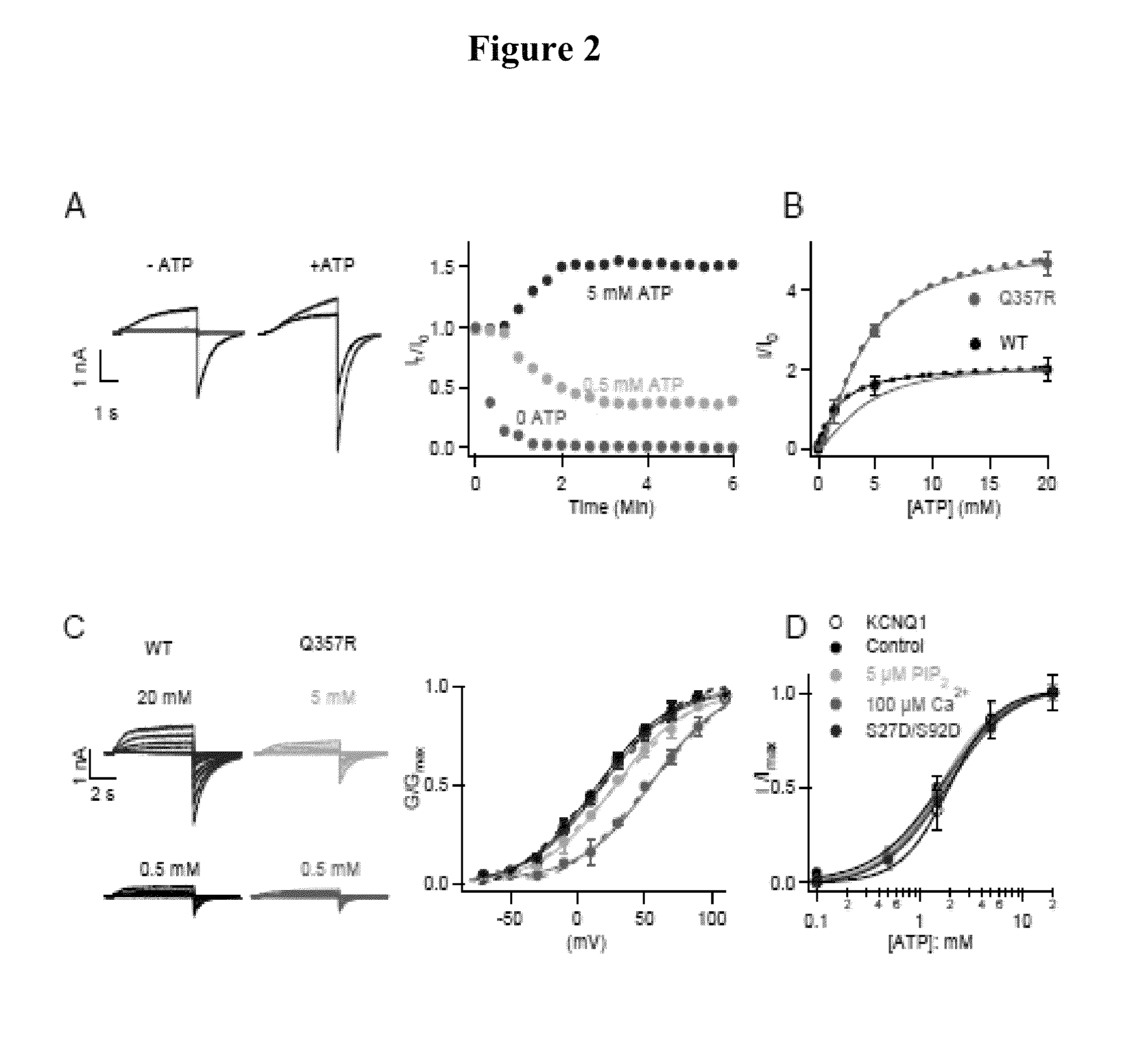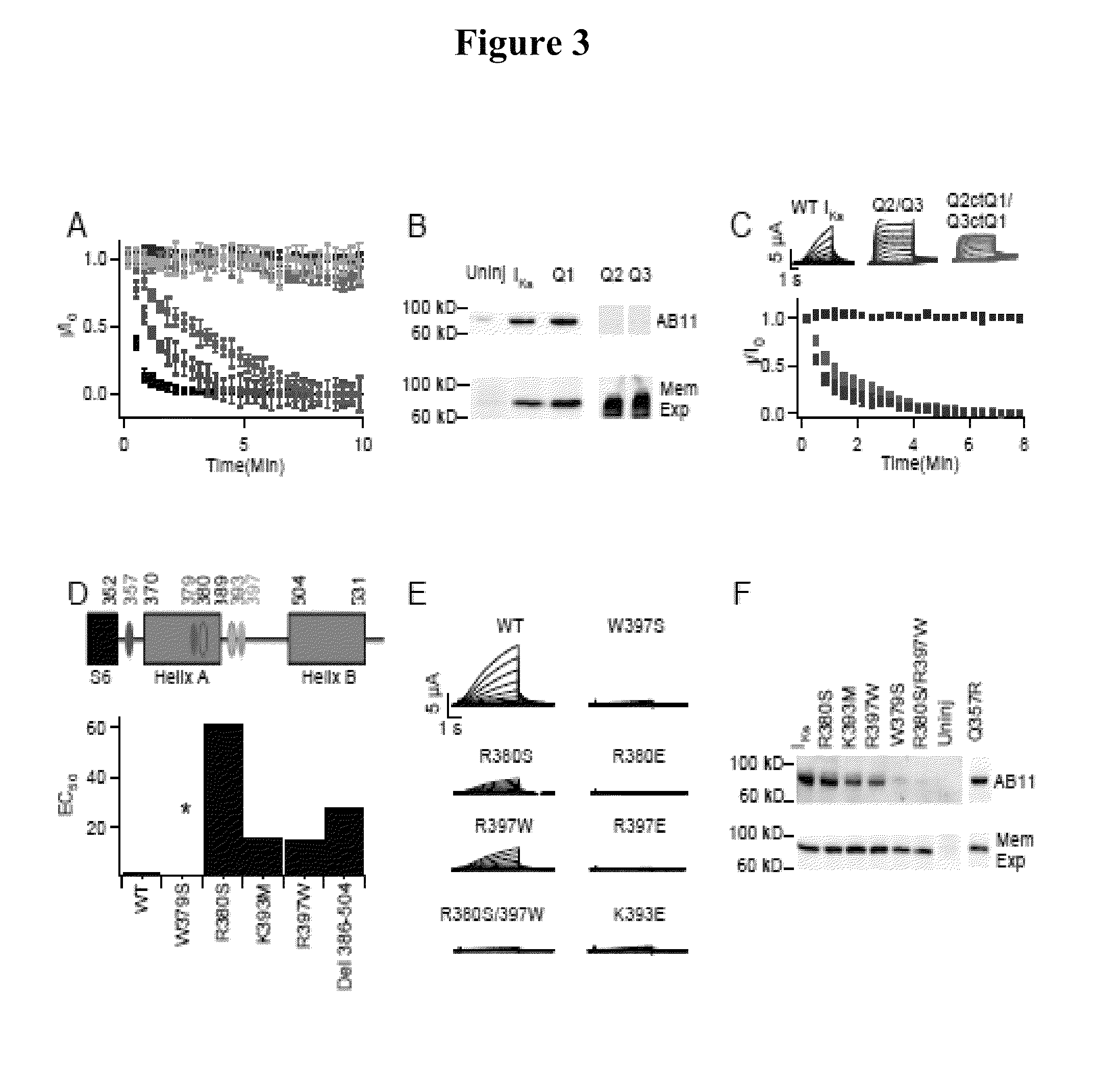KCNQ channels as therapeutic targets
a technology of kcnq channels and therapeutic targets, applied in the direction of organic active ingredients, ester active ingredients, anhydride/acid/halide active ingredients, etc., can solve the incomplete structural modeling of kcnq channels and achieve the effect of modulating the activity of kcnq channels
- Summary
- Abstract
- Description
- Claims
- Application Information
AI Technical Summary
Problems solved by technology
Method used
Image
Examples
example 1
IKs Function Requires ATP
[0109]IKs currents were examined by inside-out membrane patches from Xenopus oocytes at various intracellular ATP concentrations. Upon patch excision, current ran down in low ATP (FIG. 2A), consistent with previous findings that the loss of native ATP in cytosol resulted in reduced channel activity. See Loussouarn G. et al., EMBO J. 22, 5412 (2003). However, the current ran up in the presence of higher concentrations of ATP, suggesting that not all the channels expressed in the membrane were active with the native cytosolic ATP that is insufficient to saturate channel activation. Thus, a reserve of the IKs channels open in the presence of higher ATP concentrations, resulting in currents larger than that at the patch excision (FIG. 2A, B). The steady state current amplitude increased with ATP with the half maximal effective concentration (EC50) at 1.7 mM (FIG. 2A, B), which is close to the physiological ATP concentration in cardiac myocytes. See Allen, D. G. ...
example 2
The Physiological Importance of ATP Sensitivity of IKs
[0110]The physiological importance of IKs is supported by our subsequent finding that Q357R in KCNQ1, a LQT-associated mutation identified in patients who presented arrhythmic episodes during physical exercise reduces ATP sensitivity, as shown by an increased EC50 of ATP response and the fraction of the currents activated by applied high ATP (FIG. 2B). Here it is shown that channels composed of Q357R co-expressed with KCNE1 (Q357R IKs) produces a smaller current amplitude, a slower activation time course and a shift of the voltage dependence of activation toward more depolarized potentials as compared with the WT IKs channels measured from whole-cell currents. Each of these changes in channel properties decrease the contribution of IKs to the termination of cardiac action potentials, resulting in prolongation of action potential duration. Furthermore, application of a high concentration of ATP during inside-out patch clamp recor...
example 3
KCNQ1 Expressed Alone without KCNE1 Shows a Similar Dose Response to ATP (FIG. 2D)
[0111]This shows that the ATP dependence is an intrinsic property of KCNQ1 and not altered by KCNE1 association. IKs channels also require phosphatidylinositol 4,5-bisphosphate (PIP2) for function and are modulated by calmodulin (CaM) and phosphorylation of residues S27 and S92 in KCNQ1 by protein kinase A (PKA). However, the response of IKs currents to ATP did not change with reduced PIP2, enhanced Ca2+ or mutations S27D / S92D that mimic phosphorylation (FIG. 2D), indicating that ATP activates the channel independent from these other intracellular regulating molecules.
PUM
| Property | Measurement | Unit |
|---|---|---|
| Currents | aaaaa | aaaaa |
| Current | aaaaa | aaaaa |
| time | aaaaa | aaaaa |
Abstract
Description
Claims
Application Information
 Login to View More
Login to View More - R&D
- Intellectual Property
- Life Sciences
- Materials
- Tech Scout
- Unparalleled Data Quality
- Higher Quality Content
- 60% Fewer Hallucinations
Browse by: Latest US Patents, China's latest patents, Technical Efficacy Thesaurus, Application Domain, Technology Topic, Popular Technical Reports.
© 2025 PatSnap. All rights reserved.Legal|Privacy policy|Modern Slavery Act Transparency Statement|Sitemap|About US| Contact US: help@patsnap.com



